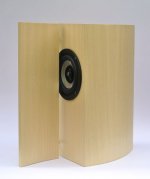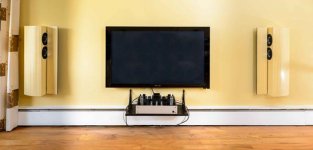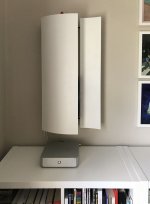Member
Joined 2009
Paid Member
I was intrigued by the Jordon Aurora (photo attached, credit: Jordan website) as it claims to address the 'front wall problem' with what appears to be a simple and elegant arrangement. I've not heard it or seen a review. I don't now how it works, but it seems that it could simple re-direct the front wall reflections off at an angle and away from the traditional listening position.
The issue of the front wall is a new topic for me, I've never given it any thought in the past. I'm eager to learn from you 🙂
The issue of the front wall is a new topic for me, I've never given it any thought in the past. I'm eager to learn from you 🙂
Attachments
Um, not sure how different this is from the Roy Allison approach of putting drivers as close to the wall as possible. Not sure what the board in front of the driver is doing though.
Similar ideas are now seen in speakers from Larsen as seen in this Stereophile page:
Larsen HiFi 8 loudspeaker | Stereophile.com
Also, of course, this idea is very similar to ground plane speaker measurements:
mh-audio.nl - Groundplane Measurement
Best,
E
Similar ideas are now seen in speakers from Larsen as seen in this Stereophile page:
Larsen HiFi 8 loudspeaker | Stereophile.com
Also, of course, this idea is very similar to ground plane speaker measurements:
mh-audio.nl - Groundplane Measurement
Best,
E
Member
Joined 2009
Paid Member
With all the worrying about pulling speakers fwd off the wall why are there so few options that offer something able to stay close to the wall?
The Larson didnt get a glowing review but it appears to be quite different, not just an angled mid but up firing cones too.
The Larson didnt get a glowing review but it appears to be quite different, not just an angled mid but up firing cones too.
Seems to me that the unexpected reflections could be worse than the actual ones, like in a badly made horn.
The easiest, thought most expensive, is a real line array where you listen in the Nearfield, and any reflections are eliminated by the Haas Effect. The sound field comes comes in a column floor to ceiling and not in an elongated sphere. Of course the Wife Acceptance Factor often prevents that.
The easiest, thought most expensive, is a real line array where you listen in the Nearfield, and any reflections are eliminated by the Haas Effect. The sound field comes comes in a column floor to ceiling and not in an elongated sphere. Of course the Wife Acceptance Factor often prevents that.
Flat (Cornu style) mains + subs would also address the 'front wall problem' pretty well, I'd imagine.
This looks like an attempt to make the reflection coincide with the direct sound (think, same as a baffle holding half space). Clearly it is somewhat physically disjointed for practical reasons, so a better job of it could be done.
I was intrigued by the Jordon Aurora (photo attached, credit: Jordan website) as it claims to address the 'front wall problem' with what appears to be a simple and elegant arrangement. I've not heard it or seen a review. I don't now how it works, but it seems that it could simple re-direct the front wall reflections off at an angle and away from the traditional listening position.
this is what it does in a certain frequency range
OTOH side-wall positioning - "Beveridge placement" looks most promising in any given rectangular room

check Yourself using this handy tool: http://www.linkwitzlab.com/LX521/Dipole%20First%20Room%20Reflections%20SL%20rev4-b.xls
from Listening_room
ps.
conventional speakers could be placed side-wall facing the back wall - instead of each other - with a kind of Jordan Aurora deflector
conventional speakers could be placed side-wall facing the back wall - instead of each other - with a kind of Jordan Aurora deflector
One solution would be to place woofer/s close to the wall and cross to a midrange that is far enough forward for the quarter wavelength of the crossover frequency to be well above the distance to the front wall. A narrow tower configuration would seem to fit.With all the worrying about pulling speakers fwd off the wall why are there so few options that offer something able to stay close to the wall?
Another solution is drivers arranged to emit a cardioid radiation pattern with the null directed at the front wall.
My understanding is that the design is primarily to aid dispersion whilsts maintaining good imagery
it deflects the first reflection off the front wall in the frequency range of the deflector, that's what it does
Me tinks that this is not a good idea.
First, the driver is 4" fullrange in a narrow box, with high directivity above 4kHz.
1) sideways near the wall will boost bass below 200Hz (good)
2) but directs high frequencies 90¤ away, (bad)
3) the reflector throws some of high frequency towards the listener (compensates a little the previous) but also makes more interferences from the nearby front wall (bad)
4) increased portion of reflected energy deteriorates stereo imaging very much (bad)
No wonder we don't see more of this kind of systems...
First, the driver is 4" fullrange in a narrow box, with high directivity above 4kHz.
1) sideways near the wall will boost bass below 200Hz (good)
2) but directs high frequencies 90¤ away, (bad)
3) the reflector throws some of high frequency towards the listener (compensates a little the previous) but also makes more interferences from the nearby front wall (bad)
4) increased portion of reflected energy deteriorates stereo imaging very much (bad)
No wonder we don't see more of this kind of systems...
I find some of the statements on the Jordan site confusing. Free standing speakers are said to provide the best sound, without describing what is meant by either. The wide baffle, shallow designs are said to provide best imagery placed close to the wall. The Aurora seems to be an attempt to have a wall mounted speaker with the advantages of a free standing speaker
This is a quote from Jordan about the Aurora
"The integral reflector is a major step forward to achieving realistic stereo imaging, surpassing even that available from free-standing speakers".
"The integral reflector is a major step forward to achieving realistic stereo imaging, surpassing even that available from free-standing speakers".
I think it is perhaps more of a defractor than a reflector given the panel appears to be close to 90 degrees to the front baffle. The high frequencies will defract off that edge with a fair portion sent towards the listener and a fair proportion sent towards the front wall to be reflected back towards the listener. It looks like a mess but there might be some sense to it if you work it through. Then again there might not.Me tinks that this is not a good idea.
First, the driver is 4" fullrange in a narrow box, with high directivity above 4kHz.
1) sideways near the wall will boost bass below 200Hz (good)
2) but directs high frequencies 90¤ away, (bad)
3) the reflector throws some of high frequency towards the listener (compensates a little the previous) but also makes more interferences from the nearby front wall (bad)
4) increased portion of reflected energy deteriorates stereo imaging very much (bad)
Member
Joined 2009
Paid Member
It often seems that these ideas turn out to be hokey, but I'm always on the look out to understand what has been done and why - for most of us (?) the idea of front wall treatments or pulling speakers out a long way from the front wall is not at all preferred. So some ideas for making speakers behave well near the front wall would be quite an attractive option. The Jordan design even looks stylish, i.e. it could have some WAF going on there. But for a company that sells some hi-end drivers for fairly high prices I assume this approach is more than hokey.
Why? Isn't most of hi-end hokey? Having looked at the Jordan web site those speakers are expensive for what they are and there is no explanation presented that I can find of how the "reflector" works. Isn't that something of a big red warning flag? If you had something that differentiated your speakers from the competition and worked wouldn't you include it in the marketing? Look at the marketing for KEF and B&W.The Jordan design even looks stylish, i.e. it could have some WAF going on there. But for a company that sells some hi-end drivers for fairly high prices I assume this approach is more than hokey.
There are a number of perfectly sensible approaches to avoiding a strong reflection off the front wall that have been around for many decades. There doesn't seem to be much of market for them.
Member
Joined 2009
Paid Member
Yes, it's red flag. But then if I had an idea and I didn't want my competitors to know the details why provide them - especially when customers are apt to accept the marketing.
I would like to know the science behind it, but of course there may be some limits to what the manufacturer will disclose. Hence why I'm interested in folks opinions here or I could have just asked Jordan.
I would like to know the science behind it, but of course there may be some limits to what the manufacturer will disclose. Hence why I'm interested in folks opinions here or I could have just asked Jordan.
- Home
- Loudspeakers
- Multi-Way
- controlling front wall reflections


